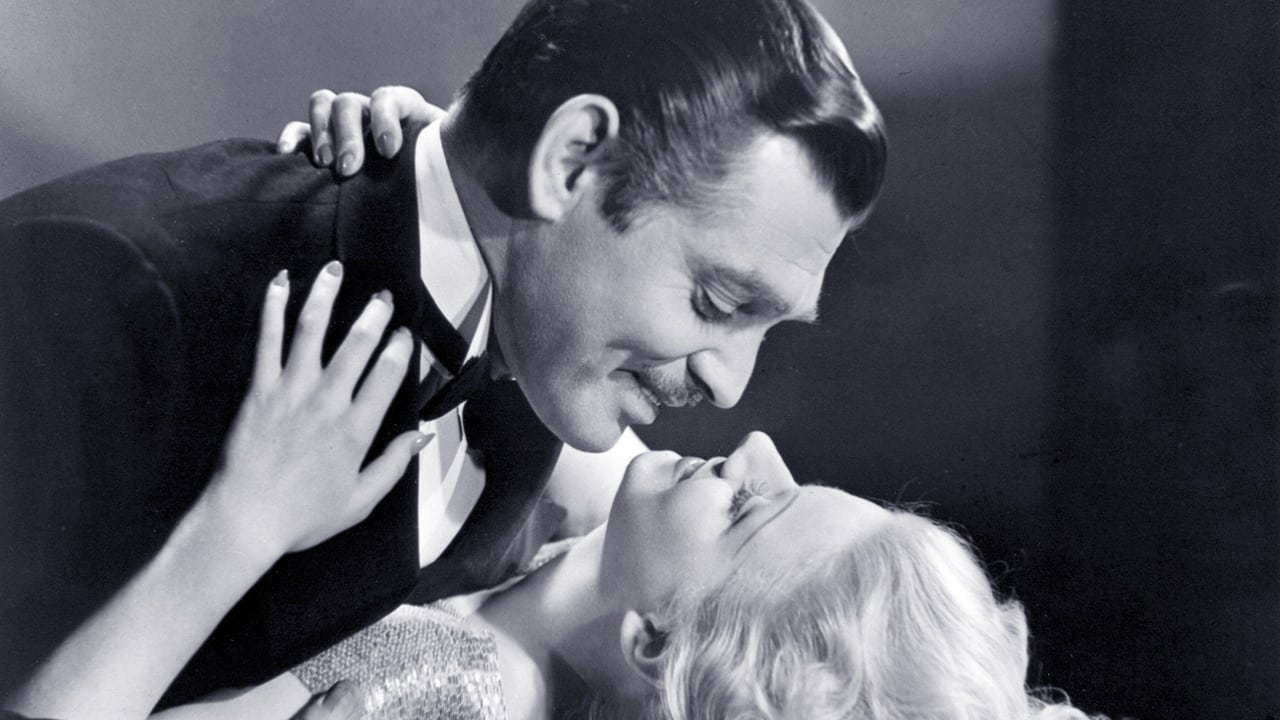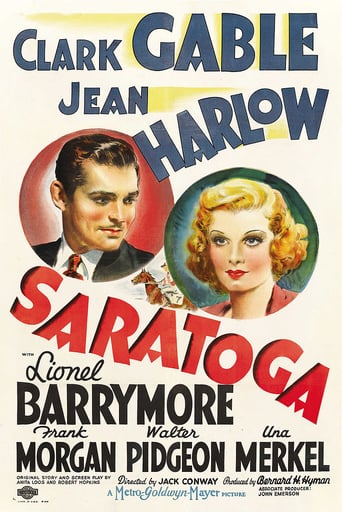

Although Saratoga is a lighthearted comedy about the horse racing game set in that former pleasure town of the rich and famous with the death of Jean Harlow while filming this movie it carries an aura of sadness that at least for me is impossible to overcome.It's an average film and not anything close to what I believe Harlow's best work on screen in such items as Libeled Lady, The Girl From Missouri, Dinner At Eight, and Red Dust. Still her final film was with her most frequent screen partner and one whom she had great chemistry with.Clark Gable plays a bookmaker who has some big IOUs from Jean's father Jonathan Hale who dies and passes those on to his daughter. Jean has an easy out if she marries wealthy Walter Pidgeon who's panting hot and heavy for her. But she eventually sees Gable is the one for her.What is also sad is that Harlow for whatever reason kept going when it is obviously apparent she's suffering from the undiagnosed uremic poisoning that eventually killed her. That's a separate issue from the legendary story that her mother's Christian Science beliefs prevented her from seeking the medical treatment that would have saved her life. Maybe she should have been replaced and the film re-shot, who can know about these things? Jean Harlow was the subject of a couple of lurid films based on Irving Schulman's book about her life that came out in the Sixties. By all accounts I've read about her from her contemporaries, Jean Harlow was a kind and gracious woman who was generous to a fault and always willing to help a newcomer. I would recommend reading Rosalind Russell's autobiography Life Is A Banquet where she talks about how Jean helped Russell the rookie on the set of China Seas.So this review is dedicated to Jean Harlow and for all the great performances she had in her that we were never destined to see.
... View More"Saratoga" (1937) directed by Jack Conway, where Jean Harlow in a scene is putting face powder during a break at the horses race on Churchill Downs and she is enough interesting as character seen from her back as style and ritual of acting, as repetitive gesture of the women in instinctive standing before society with nothing to do after the end of a given race. A trip by train and sleeping at night after talking, it is another scene of anthology from the thirties or also another, where all people around approaching, inside a saloon near the room of her, listening by the radio transmission which it seems a match of baseball, but it is a race horsing for gamblers broadcast from the stadium, interrupting their domestic activities for hearing the results of the winning horse, each time screaming as little boys. Both scenes for instance were moments of social conviviality, among bosses and employees in this comedy of happiness, waiting for the next as though nothing happened out of racing horses, except the mental health of this young woman, daughter of a land owner with horses for races. The sense of a reasonable attitude is at stake, when the daughter of the owner of racing horses refuses to take medication, before the diagnostic made by the physician in her room after a break in her health. Refusing even the recommendation of staying alone on the bed, without too much light in the room by day, because her lack of sleeping when anguish and the turmoil of her own life are surrounded by friends of these quality and glamor, by whom they care after all for her better health. It is quite instructive knowing, how it is possible after such a last derby, what of either horses won really at the place of the other ; because, at first sight, it's impossible by the line of departure directly from the stadium itself during the race. The scene where is projecting a documentary, in a special session and where the viewers were a group of friends from the horses racing, with the main characters of this fiction movie there : it is almost unbelievable of happiness for the time, with smiles in every figure and particularly of the daughter of the horses farmer, for racing in such derbies and it works well as satisfactory behavior among them, when they discovered the small difference between the winner and the second place, by the slow motion at least on the last seconds, frame by frame on the screen projection with Moon Ray in second place, viewed by them in a special room aside the stadium, like a kind of referees from this distinguished people belonging to high society.
... View MoreThis movie is a real treat for classic movie lovers! The star-studded cast includes Jean Harlow, Clark Gable, Hattie McDaniel and Lionel Barrymore. It is especially interesting for all Gone With The Wind lovers to see Hattie McDaniel (Mammy) and Clark Gable (Rhett) work together two years prior to GWTW. Jean Harlow is absolutely beautiful and really shows her acting talent in this movie. It is bittersweet to watch though, considering this was Harlow's last film. The actress worked as long as she could until the physical pain of her illness became too much and she passed away at a very young age before filming completed. The stand-in scenes are very obvious, but fortunately doesn't take away from the magic that Ms. Harlow contributed and therefore set a tone for the movie.I love this movie, and highly recommend to anyone who wants a good storyline w/ wonderful star quality!!!
... View MoreIt's hard to work up any enthusiasm for this sort of comedy from MGM. With stars of the caliber of Gable and Harlow, one expects much more than a routine story of the jet set circa 1930s amid a horsey racetrack background.Furthermore, watching it with an awareness that Harlow was gravely ill during filming makes the comedy even less enjoyable than it's supposed to be. Her illness shows in more than the make-up needed to hide the shadows around her eyes. She seems to be forcing herself to go through with any sense of comic timing for the sake of getting through the filming of a very tedious comedy. A certain listlessness can be detected in many of her scenes. The use of a double is painfully obvious toward the last third of the film.Seldom is there any inkling of the comic skill Gable showed in films like IT HAPPENED ONE NIGHT--and never is Jean Harlow anything less than remote and listless even in some of her best moments. The cigar smoking scene is the only highlight in this otherwise feeble comedy.Only bits of trivia awareness can heighten any interest in this one. Margaret Hamilton and Frank Morgan have a train scene that reminds us they were soon to be prominently featured in THE WIZARD OF OZ. Lionel Barrymore actually walks around without even a cane--and Walter Pigeon makes his MGM debut, giving perhaps the only reasonably faultless performance in a weak film.Summing up: Insignificant both as a comedy and as Jean Harlow's last film. Unfortunately, her bloated appearance and obvious signs of illness hang like a pall over most of the film.
... View More